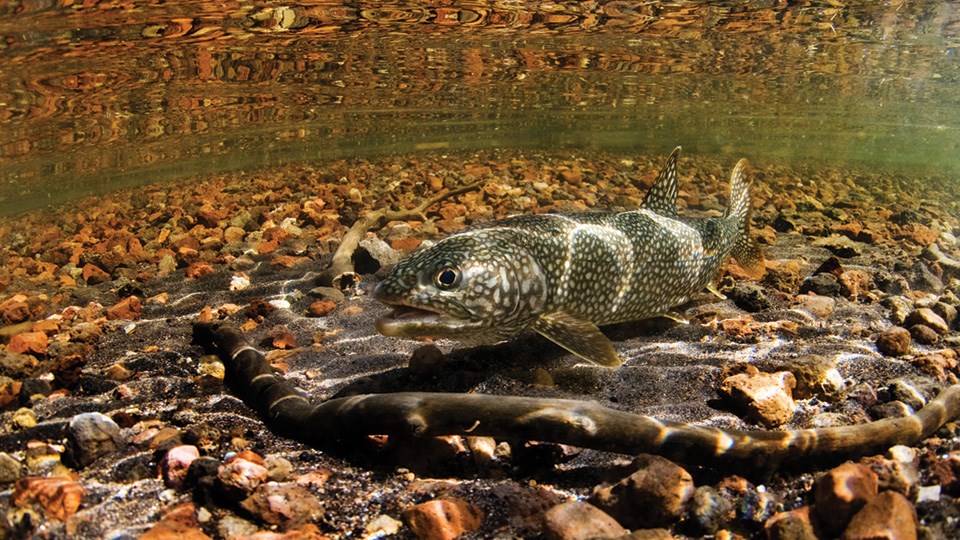
© Jay Fleming
By Mike Koshmrl, WyoFile.com
A trial run of a novel technique that combines soy-based pellets, a seed spreader and a helicopter has proved resoundingly successful at killing unwanted exotic lake trout spawn in Yellowstone Lake.
Scientists spent “hundreds and hundreds” of hours trying to trap young lakers following the deployment of the new method.
“And we caught one fry,” Yellowstone’s chief fisheries biologist Todd Koel said.
Koel and his Yellowstone National Park fisheries team have been experimenting for more than a decade to develop a practical, low-cost method of destroying lake trout eggs and fry. Interrupting the reproduction cycle is a promising potential complement to the park’s intensive gill-netting program, which has cost upwards of $30 million since around the turn of the century. Also known as mackinaw, the illegally introduced char are voracious predators that decimated the ecosystem’s native trout, the Yellowstone cutthroat. Previous methods targeting spawning beds were either ineffective or too cumbersome and expensive.
They tried electricity, suction-dredging and at one point even discussed (though never attempted) killing eggs from the fall-spawning fish with chemicals. The team attempted to smother eggs with sediment, but that wasn’t effective. Perhaps the most promising technique was using the lake trout themselves to kill their progeny: carcasses from net-caught fish were ground up, and deposited over the underwater cobble where the fish deposit their eggs. The resulting rot stripped the water of oxygen, suffocating the eggs.
“We can definitely kill embryos with carcasses, it’s just that we don’t have that much [dead fish] material to deal with in the fall,” Koel said. “Right around the same time netting boats are shutting down, we are out there trying to kill embryos on spawning sites.”
“We needed a more efficient, more clean way of applying organic material to the spawning areas,” he added.
Enter airborne veggie pellets.
Yellowstone found a fish food manufacturer in Twin Falls, Idaho, to create a soy and wheat gluten-based pellet tailor-made for the 136-square-mile lake. The pelleted plant matter is dense and it sinks, but National Park Service scientists needed an efficient means of distributing it evenly over large areas identified as spawning sites. That’s where the helicopter and seed spreader, dangled from a longline, come in.
“The seeder spreaders are just from the ag industry,” Koel said. “It’s really an efficient way to do it. The prop downdraft from the helicopter drove the pellets from the seeder down really, really hard.”
Initial trials took place back in 2018, in experimental 9-square-meter underwater plots at a known lake trout spawning site off the Thomas Bank of Yellowstone Lake’s Flat Mountain Arm. They tried five different intensities of pellet treatment. Even in the plots with the fewest pellets, mortality rates approached 100%, according to an American Fisheries Society journal article Koel and others published.
They scaled up, and it continued working.
In 2020 and 2021, scientists debuted the method at Yellowstone Lake’s oldest-known and most-used spawning site, near Carrington Island, a barely exposed rocky outcropping along the lake’s northern shoreline. Aboard helicopters, contractors spread pellets into the water over the site for about six hours each year, eventually covering 1.2 acres with $22,500 of organic material, which dissolved into a sticky film.
“It’s kind of like getting flour in your sink,” Koel said. “It hangs on there and it starts to decompose … and that drives the [dissolved oxygen] to zero and kills the embryos.”
The next step was looking for life that could withstand the resulting rot. Based on trapping in the weeks and months that followed, the film, which disappeared within a couple weeks, virtually killed everything, Koel said. In the two years of trials, the team trapped one living fry — and that wasn’t until the summer following the fall application. The alternative, according to Koel, would have been “thousands and thousands and thousands of young” at Carrington Island.
A scientific review panel that helps guide the National Park Service’s fight to restore native cutthroat trout in Yellowstone Lake has advised Koel to keep at the Carrington Island pellet treatment.
“Why wouldn’t you do what they’re doing there?” said retired U.S. Geological Survey fisheries biologist Bob Gresswell, who chairs the review panel. “If it’s not taking away from the gillnetting program at this point, nuke them till it glows.”
But going full bore with Yellowstone’s netting program should remain the top priority, Gresswell said. The park uses commercial fishing tactics, including crews imported from the Great Lakes. Destruction of the lake trout population, the ultimate goal, is all but assured if they stay at it, he said.
“It crashes,” Gresswell said. “That’s what’s happened in virtually all commercial fisheries in the world.”
Yellowstone Lake’s mackinaw population hasn’t collapsed yet, but numbers have slid down a gradual glide path and there’s ample evidence that a crash is looming, according to researchers.
At peak levels in 2012, Koel said, there were an estimated 925,000 of the exotic char, which are native to the Great Lakes and most Canadian watersheds. A decade of around-the-clock netting through the months Yellowstone Lake is ice free has slashed the estimated population to 670,000, but the size and age structure of the long-lived nonnative species has shifted dramatically.
“It’s a story of success,” Gresswell said. “There’s still high numbers of lake trout, but not high numbers of predatory lake trout.”
Lake trout become piscivorous, eating other fish, in adulthood. In Yellowstone Lake, around 30% of a mature lake trout’s diet is cutthroat trout, according to the Park Service. Fish older than 3 years are in steep decline, opening an ecological niche 2-year-old trout have especially taken advantage of.
“I’m saying this in words that send shivers up my spine, but the fish fight back,” Gresswell said. “There’s less competition for food, and so all the sudden you get this bulge of young. But if you keep fishing the adults and maintain mortality throughout, it crashes.”
After that happens, widespread deployment of the pellet-spreading technique could be a more viable way of holding Yellowstone’s lake trout population down at a basement level.
“The spawning bed sites that we know of only represent .03% of the lake surface area,” Koel said. “So an entire age class of lake trout each year is concentrated on .03% of the lake for a short period of time. If you develop methods that focus on these tiny areas in relation to the whole lake volume and surface area, just think of how far ahead you will be.”
Aerially dropping throughout Yellowstone Lake would require wading through some bureaucracy.
Yellowtone’s Native Fish Conservation Plan that enabled the intensive netting program is now a dozen years old, and the document is silent on using plant-based material to kill lake trout embryos. The park would need to do some more National Environmental Policy Act compliance to scale up, Koel said.
While promising, more research is also needed to prove that the pellet method can have a population-level effect across 394-feet-deep Yellowstone Lake. There are some limitations, too. The farther away the spawning bed sites are from Grant, where the pellets are stored, the more difficult and expensive lethal pellet showers will be, Koel said. There are also questions about drift in the water column for deeper spawning areas.
“But there are key sites outside of Carrington Island that we, biologists in the park, believe could inflict the same level of mortality,” Koel said.




